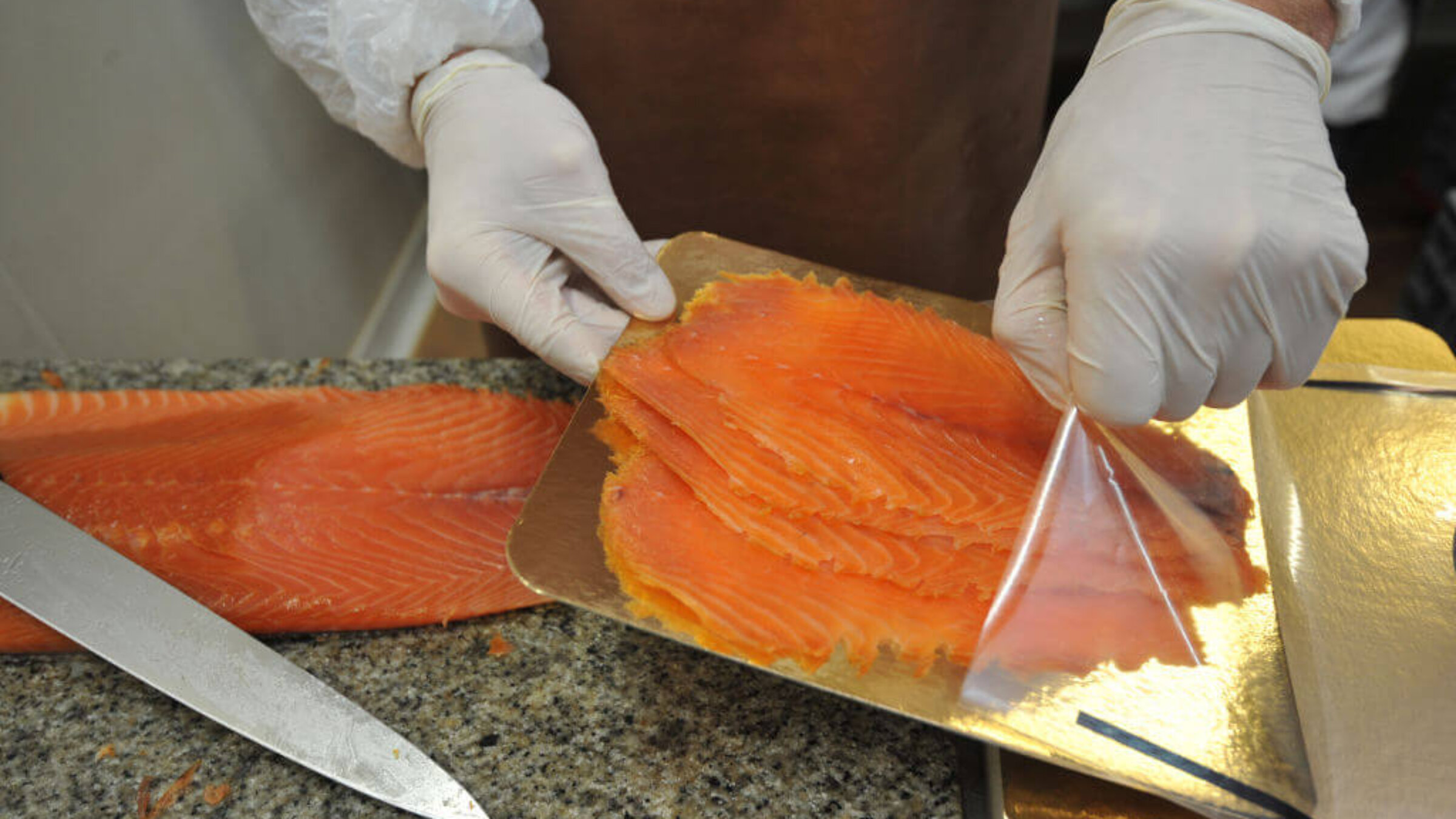The Raw Truth About Lox

A worker packages slices of salmon in a hand smoked salmon factory in Quiberon in western France on November 23, 2011. Photo by Frank Perry/AFP via Getty Images
This is the strange truth of the modern American brunch: On any given Sunday morning, the majority of people who purchase “lox” to accompany their bagels and cream cheese are not, in fact, getting lox. They may ask for lox, the product may even be labeled as lox and they very well think they are enjoying lox, but what they are getting, instead, is smoked salmon.
These days, sales of lox — salmon long-cured in a salt brine — compared to smoked salmon are astonishingly low. Mark Russ Federman, the owner of Russ & Daughters, New York’s premier appetizing store, estimates that lox accounts for only 15% to 20% of his salmon sales, which is actually a far higher number than it is at most retail outlets. This is attested to by the smokehouses that process and sell cured salmon to supermarkets and bagel stores around the country. At Banner Smoked Fish of Coney Island, for instance, lox sales total only about 5% of those for smoked salmon. At Acme Smoked Fish in Williamsburg, Brooklyn, the largest smoked-fish house in the continental United States, the percentage is lower still; on average, Acme sells some 25,000 to 30,000 pounds of smoked salmon a week, while sales of lox might not exceed 1,000 pounds.
The reason for this, quite simply, is changing American tastes. “It’s not just lox,” Avi Attias, the owner of Banner Smoked Fish, told the Forward. “Everything that’s salty is going down.” The smoked-fish trade is rife with stories of customers who order a shipment of “lox” and then, having received it, send it back, complaining that it’s too salty. This is why smokehouses will commonly double-check a lox order, making sure that the customer really means lox, rather than the milder-tasting smoked salmon. As the saying that is widespread in the business has it, “You can’t get lox without a note from your mother.”
Lox and smoked salmon are both examples of what is known as cured fish. “Curing” a fish — like curing meat or cheese or any other foodstuff — means to treat it for the purposes of preservation. This can be done by any one of several methods (or a combination of methods), including pickling, smoking and salting. In salt curing, the fish is packed in salt or, alternatively, submerged in a salty brine. The salt kills potentially harmful bacteria and also absorbs the moisture in which bacteria grow, resulting in a product that can be safely preserved for long periods of time without refrigeration. In smoke curing, the fish is subjected to several hours of wood smoke, which deposits tarry substances on the surface of the fish. Like salting, the smoking process kills bacteria while also creating an impermeable seal on the fish that reduces exposure to air, which can cause rancidity in fats. This is especially useful for fattier foods (bacon, for instance, or oily fish such as herring), but as a rule smoking is a less efficient preservation technique and is usually performed in conjunction with another curing method.
Water, salt, wood, fire: The ingredients for curing fish are as elemental as the earth and the process nearly as old as civilization. Salted fish, notes Mark Kurlansky in “Salt: A World History” (Walker, 2002), have been found in Egyptian tombs dating to before 2000 BCE, while halfway around the world, Chinese records from the second millennium BCE also describe the preservation of fish in salt. In Europe, the earliest preserving was done with smoke; the remains of a fish-smoking station found along the River Bann in Ireland date to just about the same period — 2000 BCE — some 1,500 years before the salting of fish began to appear in Western Europe.
Exactly when Jews first began to cure fish is not known for certain; the place of origin was likely medieval Germany, where the curing of fish had long been practiced. With the eastward migration of the late Middle Ages, the Jews carried their techniques for smoking and salting fish to Eastern Europe. There, as elsewhere around the world, Jews were prodigious fish-eaters. Fish is considered pareve and so can be eaten with either meat or dairy products; smoked and salted fish was especially popular, because it was not cooked and thus, said the rabbis, permissible to eat even if prepared by non-Jews. (Salmon, by the way, was far too expensive for most Eastern European Jews; herring and carp were the staple fish.) The late 19th century brought the mass immigration from Eastern Europe, and Jews began to establish fish-smoking establishments in the West, including in London — the illustrious smokehouse H. Foreman & Son, for example, founded in 1905 by a Russian-Jewish immigrant and still operating in the East End — and especially in New York. The original New York smokers had been German, but by the end of World War I the business had become, for all intents and purposes, a Jewish one.
Herring continued to be extremely popular among Jews in the New World (at least for another generation or two), but now it was supplemented by salmon, which in the United States was comparatively cheap and plentiful. In those days all salmon were caught in the wild and then shipped from the place of capture by train. Refrigeration, of course, had not yet been invented, and so the salmon were packed in salt to preserve them during the long train ride. This heavily salted salmon — known in Yiddish as lox, from the German word for salmon, Lachs — remained pretty much the only game in town until the 1940s, when the advent of large-scale refrigeration rendered salting unnecessary, thus paving the way for the introduction of smoked salmon.
Lox is sometimes referred to as a variety of smoked salmon (as smoked salmon is sometimes known by the generic term “lox”), but this is a mistake, for no smoke is used making lox. Instead, the salmon is immersed in a salt brine — just salt and water, nothing else — for anywhere from three to six months, after which the fish is removed and then briefly washed to remove excess salt. This is the entire process. At no point is the salmon subjected to any smoking, any drying or even any heating. (Mark Federman of Russ & Daughters likes to refer to lox as “Jewish sushi.”)
In the old days, the lox came either from wild Pacific salmon or wild salmon caught in the waters off Nova Scotia or the nearby Gaspé Peninsula in Quebec. Today, wild Atlantic salmon is seriously in danger of becoming extinct, and Atlantic salmon comes instead from vast fish farms, most of them in Norway and Chile, with others in the Faeroe Islands, near Scotland. (Though Chile borders the Pacific Ocean, its salmon came originally from Norway and so is considered Atlantic.) Farm-raised Atlantic salmon are richer and fattier than their wild counterparts, which makes sense, given their comparatively sedentary lifestyle (no swimming upstream to spawn and so forth). Wild Pacific salmon, most of which come from Alaska, tend to have a stronger taste and a firmer texture, although paradoxically enough, they create a softer lox, for reasons that no one in the business seems able to explain fully.
Although the term “Nova” originally referred to lox, today it most often refers to smoked salmon, which is testament to the dramatic shifts that have taken place in the appetizing case.
Nowadays, Nova refers not to a type of fish, but rather to a type of smoking, one that has been tailored to the tastes of New York consumers. Said Buzz Billik, vice president of sales at Acme, “There are pockets in the Midwest and the West Coast that enjoy heavier smoke in the product, but this isn’t a New York taste preference. Here they like it lightly salted, lightly smoked.” At Acme, the salmon (which, as is standard in the business, almost always arrive frozen and must first be defrosted) are placed in tubs of brine containing a mixture of salt and brown sugar. They remain in these tubs in the curing room — which, like most parts of a smokehouse, is quite chilly, about 38 degrees — for seven days, at which point they are removed from the brine and laid out on metal screens for smoking. The salmon are smoked for 18 to 24 hoursº at a temperature ranging from about 70 to 76 degrees. This process, known as “cold smoking,” imparts flavor and removes moisture, creating the firm, silky texture that allows the fish to be thinly sliced. Hot smoking, which produces baked — also called “kippered” — salmon, is begun at 100 degrees and then proceeds upward to 200 degrees, with a total cooking time of some six to eight hours. (This must be done slowly, otherwise the fish will broil, tearing the skin and turning the flesh milky.)
The wood Acme uses for its smoking is a blend of apple and cherry, which, said Billik, “adds flavor to the cure.” At Banner, Avi Attias uses maple for his smoking and disparages the use of fruitwood for smoking fish. “Hickory is best for meat, hardwood for fish,” he said. “Fruit gives it a sweet smell, but we’re not selling candy, we’re selling fish.”
Attias, who is in his mid-30s, started in the fish business when he was 16. (“Why?” he said amusedly. “Because I’m an idiot — I should have gone to college.”) At Acme, the fourth generation of the Caslow family is now working in the company, and, as it happens, this is true at Russ & Daughters as well, where Mark Federman has recently brought on his daughter Niki and nephew Josh to work in the store. The smoked-fish trade is going strong, and its New York outposts seem to be assured of at least another generation’s span. Whether, at the end of that time, they will still be producing and selling lox is anybody’s guess.

I hope you appreciated this article. Before you go, I’d like to ask you to please support the Forward’s award-winning journalism this Passover.
In this age of misinformation, our work is needed like never before. We report on the news that matters most to American Jews, driven by truth, not ideology.
At a time when newsrooms are closing or cutting back, the Forward has removed its paywall. That means for the first time in our 126-year history, Forward journalism is free to everyone, everywhere. With an ongoing war, rising antisemitism, and a flood of disinformation that may affect the upcoming election, we believe that free and open access to Jewish journalism is imperative.
Readers like you make it all possible. Right now, we’re in the middle of our Passover Pledge Drive and we still need 300 people to step up and make a gift to sustain our trustworthy, independent journalism.
Make a gift of any size and become a Forward member today. You’ll support our mission to tell the American Jewish story fully and fairly.
— Rachel Fishman Feddersen, Publisher and CEO
Join our mission to tell the Jewish story fully and fairly.
Only 300 more gifts needed by April 30
























